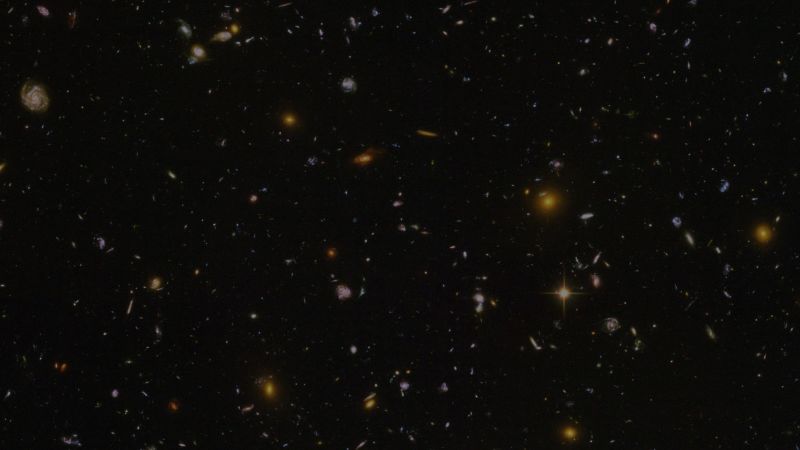When NASA’s Double Asteroid Redirection Test spacecraft intentionally slammed into the asteroid Dimorphos in September 2022, the impact may have caused “global deformation” of the space rock, according to new research.
The goal of the DART mission was to carry out a full-scale test of asteroid deflection technology on behalf of planetary defense and to see whether a kinetic impact — like crashing a spacecraft into an asteroid at 13,645 miles per hour (6.1 kilometers per second) — would be enough to change the motion of a celestial object in space.
Dimorphos is a moonlet asteroid that orbits a larger parent asteroid known as Didymos. Neither pose a threat to Earth, but the double-asteroid system was a perfect target to test deflection technology because Dimorphos’ size is comparable to asteroids that could pose a threat to Earth.
Since the day of impact, astronomers have used data from ground-based telescopes to determine that the DART spacecraft did change Dimorphos’ orbital period — or how long it takes to make a single revolution around Didymos — by about 32 to 33 minutes. But another crucial piece of information needed to understand how to deflect asteroids that may be on a potential collision course with Earth in the future is the composition of space rocks.
Different types of asteroids that pose a threat — whether hard, stony asteroids or rubble piles, which are effectively loose piles of rock held together by gravity — would require different deflection techniques.
The DART mission ended upon impact, but prior to colliding with Dimorphos, the spacecraft transmitted an incredibly detailed view of the little asteroid’s boulder-covered surface that is helping researchers learn more about how the space rock formed.
Astronomers were also able to carry out follow-up observations with ground- and space-based telescopes, and with the Italian LICIACube satellite that briefly followed the DART mission and imaged the aftermath for 5 minutes and 20 seconds.
The observations revealed that the impact unleashed a giant debris plume of material into space.
Now, researchers have taken the investigation a step further by putting all this data into software to help answer key remaining questions, such as determining how the asteroid reacted to the collision and what kind of crater was left behind.
Rather than forming a simple crater on Dimorphos, the DART impact reshaped the entire asteroid, the results have suggested. A study describing the findings appeared Monday in the journal Nature Astronomy.
The findings could prepare astronomers for what they will find when future missions fly by Dimorphos to better understand the effects of asteroid deflection technology.
Recreating the DART impact
A team of researchers modeled the impact using the Bern smoothed-particle hydrodynamics shock physics code to achieve their results.
It’s “a computational tool designed to simulate impact events. Shock-physics codes in general are essential in the study of collisions and impact processes. They incorporate various models, including material models and porosity models, to accurately represent the physical conditions during hypervelocity impact events, such as high pressures and temperatures,” said lead study author Dr. Sabina Raducan, postdoctoral researcher at the department of space research and planetary sciences at the University of Bern’s Physics Institute in Switzerland.
The software has been validated by replicating other impacts, including when Japan’s Hayabusa2 spacecraft punched a small copper impactor into the Ryugu asteroid in 2019.
The team ran 250 simulations to recreate the first two hours following the DART impact based on the data they did have while varying the factors they didn’t know, “such as the closeness of packing of boulders, their density, the porosity of material and its overall cohesion. We also made some reasonable assumptions based on the physical properties of meteorites resembling Dimorphos,” Raducan said.
After running their simulations, the team focused on the one that most closely matched the original DART data.
The results indicated that Dimorphos is a rubble pile made of rocky material shed from the Didymos asteroid, held together by weak gravity.
“On Earth the force of gravity is such that cratering occurs briefly, producing a typical cratering cone angle of around 90 degrees,” said study coauthor Dr. Martin Jutzi from the University of Bern’s Physics Institute, who is also cochair of the Hera Impact Physics Working Group, in a statement. “What we saw with DART’s impact of Dimorphos was a much wider ejecta cone angle extending by up to 160 degrees, influenced mainly by the curved shape of the asteroid’s surface. And the crater kept on expanding, because both the gravity and material cohesion is so low.”
As a result, the crater basically grew to encompass all of Dimorphos, completely transforming the asteroid’s shape.
The Hera mission
Raducan and Jutzi are part of the investigation team participating in the European Space Agency’s Hera mission, which will launch a spacecraft in October on a journey to observe the aftermath of the DART impact, arriving near the end of 2026. Together with a pair of CubeSats, the mission will study the composition and mass of Dimorphos and how it was transformed by the impact and determine how much momentum was transferred from the spacecraft to the asteroid.
“Our simulations suggest that Dimorphos has had its initial flying saucer shape blunted on its impact side: if you think of Dimorphos as starting out as resembling a chocolate M&M, now it would look like it has had a bite taken out of it!” Raducan said.
Queen guitarist and astrophysicist Sir Brian May, along with his collaborator, chemical engineer and material researcher Claudia Manzoni, also shared stereoscopic images to help the team determine more about the reshaping event.
The team believes that 1% of Dimorphos’ entire mass was kicked out into space due to the impact, while 8% of the asteroid’s mass was shifted around.
“Hera will probably not be able to find any crater left by DART,” Raducan said. “What it will discover instead will be a very different body.”

